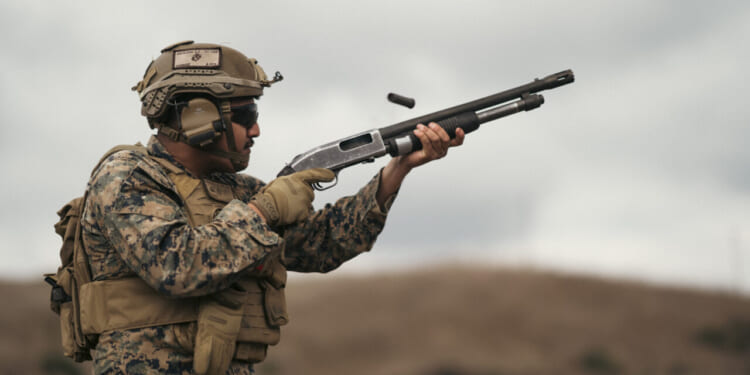Shotguns are the last line of defense for soldiers when all other counter-drone measures have failed.
Battlefield drones have emerged as the Ukraine war’s preeminent weapon system, with some estimates crediting them with 80 percent of the war’s combat casualties so far. Counter-drone combat systems have developed a layered approach to drone defense to address the wide range of drone types and capabilities. An older technology has proven to be perhaps the best way for ground troops to defend themselves against small First Person View (FPV) drones that are so ubiquitous in Ukraine: the shotgun.
Defence Blog’s Dylan Malyasov recently interviewed Marco Angelelli, shooting instructor and president of the Italian Federation of Clay Shooting Commission for Relations with the Armed Forces. Drawing on experiences from Ukraine, Angelelli is heavily involved in training Italy’s military to counter small, close-range FPV drones with shotguns.
An Old Solution to a New Challenge
The interview notes that the drone swarms in Ukraine are unprecedented, forcing Ukrainian soldiers to adapt quickly. Individual soldiers using shotguns have been among the most effective of those adaptations. Ukraine’s 413th Separate Raid Battalion has established a dedicated training program for using shotguns in that role. The program makes use of traditional skeet shooting techniques but injects the drones’ unpredictable movement capability into the mix. Students also shoot from moving truck beds and spring-mounted platforms that vibrate as they move and shoot, forcing proper fundamentals and a solid shooting base. Four hundred soldiers have completed the course in the seven months since its creation.
Angelelli is calling for such programs to be implemented across NATO to teach soldiers last-ditch defensive capabilities against small, close-range FPV drones. Shotguns provide a quickly deployed platform that soldiers can use to defend themselves and their comrades in last-ditch situations. A shotgun’s dispersal pattern, with the proper ammunition, can bring down even highly maneuverable drones at short range with an accurate shot.
A Dedicated Anti-Drone Weapon
Italy has created its own training school for anti-drone tactics in Pisa. The school and the Italian armed forces are using the new Benelli M4 AI Drone Guard shotgun, which was developed by Beretta Defense Technologies. The Benelli M4 is a well-proven military and law enforcement platform, so it was a natural choice for a specialized anti-drone variant.
The M4 AI Drone Guard is optimized for engaging drones out to 50 meters, with an extended range of up to 100 meters, depending on conditions. The gun uses special tungsten-based lead ammunition in Norma Governmental AD-LER cartridges for counter-drone work. The dense tungsten pellets deliver a concentrated, penetrating impact, increasing the likelihood of a kill. Each cartridge contains 350 No. 6 (2.75mm) tungsten pellets for maximum coverage in the cone.
Benelli is also offering counter-drone training courses for troops equipped with the M4 AI Drone Guard. Angelelli notes that other European countries have purchased the Benelli and are standing up training programs. He believes NATO should create such a program, alliance-wide, since the drone threat is not going away.
The US military has already developed a similar tungsten-based round, with smaller No. 9 pellets, for which Mossberg is building a shotgun to the War Department’s specifications.
Shotguns are Only One Layer
For all his enthusiasm, Angelelli stresses that shotguns are merely the last line of defense for individual soldiers when all other counter-drone measures have failed. The shotguns are meant for them to defend their own lives and those of their fellow soldiers.
Some skeptics argue that shotguns are outdated and not suitable on the modern battlefield, but the Ukraine war seems to disprove that notion. The Ukrainian Army certainly thinks so, and it has the experience to back it up. Angelelli suggests viewing shotguns as adaptable tools instead of old technology. Drones have evolved far beyond their initial roles, even over the last three years of war. Shotguns appear to be doing the same.
You can read Defence One’s complete interview with Marco Angelelli here.
About the Author: William Lawson
William Lawson is a military historian focusing on World War II and 20th century conflicts and the American Civil War. His specialty is operational level warfare, especially American amphibious doctrine. He writes on history, politics, and firearms for multiple publications and historical journals. He serves on the editorial advisory board for the Saber & Scroll Journal and Military History Chronicles and is a member of the Society for Military History and the American Historical Association. Lawson is based in Virginia.
Image: DVIDS.

















